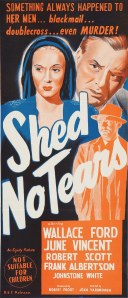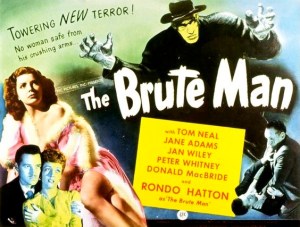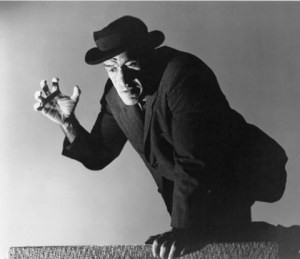 If I’ve said it once, I’ve said it a million times … only a chump fakes his own death.
If I’ve said it once, I’ve said it a million times … only a chump fakes his own death.
And yet, that’s exactly what Sam Grover (Wallace Ford) does in the very first scene of Jean Yarbrough’s Shed No Tears. He sets fire to his hotel room and leaves a cadaver behind as he sneaks out the back way. It’s all part of a scheme he’s cooked up with his wife Edna, an icy blonde played by June Vincent, whose best-known film noir performance was probably in Roy William Neill’s Black Angel (1946).
Edna is as young and beautiful as Sam Grover is middle-aged and schlubby. When an old woman on the bus sees Sam looking adoringly at a picture of Edna, she asks him if it’s a picture of his daughter. “My granddaughter,” he responds with a sigh.
If you’ve ever seen a B noir before, you’ll know that Edna’s up to no good before Sam even kicks over the flaming wastebasket in his hotel room, but all doubt is erased a few minutes into the film when Sam scurries off to hide out and Edna falls into the well-muscled arms of her handsome young boyfriend Ray (Mark Roberts, listed in the credits as “Robert Scott”).
The plot thickens when Sam’s adult son, Tom (Dick Hogan), suspects foul play and engages the services of a slippery and pompous private investigator named Huntington Stewart (Johnstone White). Meanwhile, Sam grows restless in hiding and gets itchier and itchier as he waits for Edna to come through with the insurance dough for his “death.”
Shed No Tears is based on the novel by Don Martin. Its dialogue is heavy on exposition, but the editing and visual storytelling are tight. The acting by everyone except the always dependable Wallace Ford is merely passable, with Dick Hogan’s stilted performance qualifying as the most egregious. I suspect that he was cast more for his cute little face than for his acting ability. Incidentally, this was one of Hogan’s last roles. After Shed No Tears he would go on to appear in the Alan Ladd vehicle Beyond Glory (1948) and Alfred Hitchcock’s Rope (1948), in which he played the murder victim.
Shed No Tears never rises above the level of a B-movie programmer, but for what it is, it’s an entertaining 70-minute melodrama. It’s in the public domain, and there’s an OK-looking DVD available from Alpha Home Entertainment that was transferred from a 16mm print. There are also a few versions currently streaming on YouTube:


